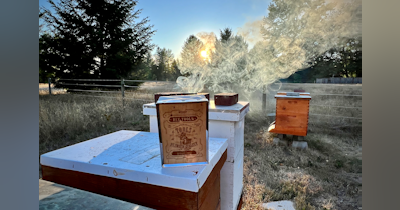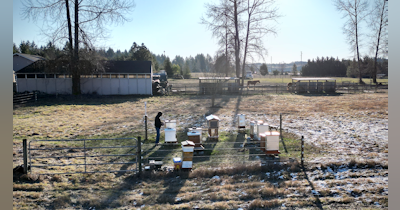Baby, it’s getting warm out there!
We recently received a voicemail from a listener who asked about the impact of unseasonably warm temperatures on beekeeping management. She is not alone in noticing advanced colony growth this year. A record eight states have recorded their warmest winter on record (https://www.noaa.gov/news/us-had-its-warmest-winter-on-record) and that can impact your honey bee colonies. While early warmer temperatures can benefit your bees, it can also create life threatening conditions in your colonies. Here are a few tips to help you manage colonies during unseasonably warm winters and springs:
Check your food stores and feed your bees if necessary. If temperatures in your region have been warmer than usual and your bees are bringing in fresh pollen, they might be rearing more brood than usual and depleting their food stores. Large populations, warmer weather, and a lack of significant incoming nectar could be perilous to the supply of honey that your bees have in the spring. Regular inspections and checks for ample carbohydrates are critical if the worker population is growing without being replenished. If daytime temperatures are consistently above 50 degrees F, you may feed with 1:1 sugar syrup until the flowers catch up with your colony’s nutritional needs. Feeding a pollen supplement, even when fresh pollen is available early, will provide a protein source to your bees in case temperatures dip below foraging friendly conditions.
Check for space, reverse and/or add brood boxes. If your bees are bursting and you are weeks from being able to split (divide) your colonies, you can take a couple of steps to make sure they have space to expand. These steps could help prevent crowding conditions that encourage swarming. Reversing your boxes (bottom to top) is the first step to making sure your bees are using their space effectively. Follow the rule of not splitting the brood nest if you decide to incorporate these reversals into your management program. Cooler overnight temperatures will result in colonies clustering and they could leave the brood chilled if your reversal created two brood nests.
Alternatively, If you have empty drawn comb, you can added a box to the top of your colony if your bees are running out of space. Finally, check out the Demaree Method to deter swarming and encourage early honey production. Steve Donohoe’s website details this method and the pros and cons of this practice (https://thewalrusandthehoneybee.com/demaree/).
Update your mite management strategy. Early brood production might be great for your bees, but it is even better for Varroa destructor mites. Warmer seasons encourage honey bee brood production and as a result, varroa mites will increase as well. Check out the Honey Bee Health Coalition’s varroa management website and update your strategy in order to stay ahead of this virus vectoring parasite (https://honeybeehealthcoalition.org/resources/varroa-management/).
Early springs can bring populous colonies sooner than expected. But unseasonably warm and unpredictable weather can also result in hungry and/or crowded colonies. Strong early season colonies will boost the population of varroa mites. The bright side of an early spring means that with a little planning and a few more trips to your apiary, your bees might be able to take advantage of an early nectar flow resulting in a surplus honey crop.
Thanks to our listener who asked us about what steps she could take to keep her bees healthy this spring. Leave your comments and thoughts below.
If you have a question that you want us to tackle, contact us here.



 Update your mite management strategy. Early brood production might be great for your bees, but it is even better for Varroa destructor mites. Warmer seasons encourage honey bee brood production and as a result, varroa mites will increase as well. Check out the Honey Bee Health Coalition’s varroa management website and update your strategy in order to stay ahead of this virus vectoring parasite (
Update your mite management strategy. Early brood production might be great for your bees, but it is even better for Varroa destructor mites. Warmer seasons encourage honey bee brood production and as a result, varroa mites will increase as well. Check out the Honey Bee Health Coalition’s varroa management website and update your strategy in order to stay ahead of this virus vectoring parasite (











